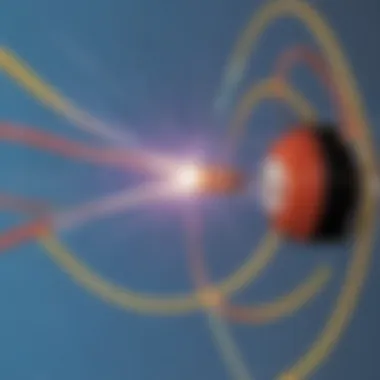Understanding the Functionality of Electromagnets


Intro
Electromagnets play an integral role in our modern world. They form the foundation for various devices and machines, from electric motors to magnetic levitation trains. To understand how they work, we need to examine the underlying principles that govern electromagnetism. This section aims to clarify the relation between electricity and magnetism, providing a concise overview of what electromagnets are and how they influence our lives.
Electromagnets are created by running an electric current through a coil of wire, often wrapped around a ferromagnetic core. This phenomenon generates a magnetic field, transforming the core into a magnet. This process is crucial for countless applications, such as in cranes that lift heavy metal objects, maglev trains that float above tracks, and even in our everyday household devices like speakers and doorbells.
As we delve deeper into the specifics of electromagnets, we will uncover fascinating facts that showcase their remarkable capabilities and the impact they have on technology. Let's begin with some interesting insights that will enrich our understanding of this captivating subject.
Foreword to Electromagnetism
Electromagnetism is a fundamental topic in physics that connects electricity and magnetism. Understanding how these two forces interact enriches our comprehension of various technologies that pervade everyday life. This section introduces the significance of electromagnetism, focusing on its principles, applications, and how it shapes modern technology.
An electromagnet is a type of magnet that becomes magnetized when an electric current passes through it. This unique feature allows for easy control of the magnetic field, making electromagnets exceptionally valuable in countless devices. By studying electromagnetism, one can gain insights into the workings of electric motors, magnetic locks, and even medical equipment such as MRI machines.
Definition of Electromagnet
An electromagnet is defined as a magnet in which the magnetic field is produced by an electric current. This distinguishes electromagnets from permanent magnets, which have a persistent magnetic field. The strength of an electromagnet can vary by altering the electric current, which allows for more versatile applications. Electromagnets consist of a coil of wire, often wound around a core, typically made from a ferromagnetic material like iron. When electric current flows through the wire, a magnetic field is generated around the coil, and the core material enhances this magnetic field, resulting in a stronger magnet.
"Electromagnets are integral to modern technology, enabling operations in many devices we use daily, from electric bells to large machinery in industries."
Historical Background
The concept of electromagnetism has deep historical roots, evolving over centuries. The discovery of electromagnetism can be attributed to scientists like Hans Christian Ørsted, who in 1820 demonstrated that electric currents generate magnetic fields. This key experiment led to further exploration by Michael Faraday, who established the principles of electromagnetic induction. His work laid the groundwork for future innovations, including the invention of the electric generator and transformer. The collaboration and competition among scientists of that era fostered advancements that significantly shaped technology today.
In the following decades, the discoveries made in electromagnetism translated to practical applications like telegraphs and motors. By the late 19th century, these developments would go on to revolutionize transportation and communication. Understanding the historical context of electromagnetism not only provides insight into the scientific progress but also highlights its relevance in modern advancements.
Basic Principles of Electricity and Magnetism
The basic principles of electricity and magnetism form the foundational concepts necessary to understand how electromagnets work. These principles provide an insight into the interplay between electric charges and magnetic fields. Recognizing these relationships is crucial when exploring the functionality and applications of electromagnets in various technologies.
Electric Current
Electric current refers to the flow of electric charge through a conductor, such as a wire. It is measured in amperes (A). The flow occurs when there is a difference in voltage across the conductor. This movement of charge can be thought of as the lifeblood of electromagnets.
When an electric current passes through a coiled wire, it creates a magnetic field around the wire. This magnetic field is what distinguishes an electromagnet from a simple magnet. In practical terms, without electric current, electromagnets would not be able to function.
Magnetic Fields
A magnetic field is an invisible field that exerts a magnetic force on substances within it. It is generated by magnetic materials or by moving electric charges. Magnetic fields are defined by their direction and strength, with lines of force that show how strong the magnetism is at various points.
For the electromagnet, the strength of the magnetic field increases with higher current and more coils of wire. This is essential for applications that require a strong magnetic force. The simple rule is: more current and more coils mean a stronger magnetic field.
Relation Between Electricity and Magnetism
The relationship between electricity and magnetism is a fundamental concept in physics known as electromagnetism. This principle is described by Maxwell's equations, which show how electric charges produce electric fields and how changing electric fields produce magnetic fields.
Electromagnets illustrate this relationship beautifully. By applying electric current to a wire, a magnetic field is generated. Conversely, moving a magnet through a coil of wire induces an electric current in the wire. This direct correlation is crucial to understand many devices, such as electric generators and transformers.
"Electricity and magnetism are interrelated aspects of a single phenomenon — electromagnetism."
The basic principles of electricity and magnetism form the bedrock of how electromagnets operate, making them vital for various applications in our modern world.
Components of an Electromagnet


Electromagnets are fascinating devices whose functionality depends on a few essential components. Understanding these components helps to grasp the principles behind how electromagnets generate magnetic fields. Each part plays a crucial role in ensuring the efficiency and effectiveness of the electromagnet.
Wire Coil
The wire coil is the backbone of an electromagnet. It consists of copper or another conductive material wound in a series of loops. This coil is crucial because when an electric current flows through it, it creates a magnetic field. The strength of this magnetic field depends on several factors, like the number of loops in the coil and the intensity of the current. More loops generally lead to a stronger magnetic field. Since the wire must efficiently conduct electricity, using a material with low resistance, like copper, is recommended. This characteristic allows more current to flow through the coil, enhancing the magnetic effect.
Core Material
The core material inside the coil significantly enhances the electromagnet's strength. Typically, iron or other ferromagnetic materials are used. When the electrical current passes through the coil, the magnetic field magnetizes the core, making it much stronger than the original field produced by the coil alone. This process, known as magnetization, increases the overall magnetic effect without needing a proportional increase in electrical current. However, it is essential to choose the right type of core material. For instance, materials with high magnetic permeability can significantly amplify the field strength, making them suitable for various applications.
Power Source
The power source is the final and equally crucial component of an electromagnet. It provides the electrical current necessary to energize the wire coil. Common sources include batteries or power supplies that can deliver the required voltage and current. When selecting a power source, consider the electromagnet's design and purpose. Some applications may need a higher voltage to achieve the desired magnetic strength, while others may function correctly with a standard battery. It is essential to ensure that the power source can handle the electrical load without overheating or failing.
"The combination of wire coil, core material, and power source determines an electromagnet's efficiency and performance."
By focusing on these components, one can appreciate how electromagnets work and their versatility in different applications.
How Electromagnets Work
Magnetization Process
The magnetization process is fundamental to the functioning of electromagnets. When an electric current flows through a wire coil, it creates a magnetic field around it. This field is produced by the motion of electrons and their charge. The effect is significant; even a small electric current can generate a measurable strength in magnetic force.
The strength and direction of the magnetic field depend on several factors. First, the number of wire turns in the coil increases the magnetic field strength. A more coiled wire leads to a more concentrated and stronger magnetic field. Second, the material placed inside the coil, known as the core material, can enhance the magnetization. Materials like iron significantly improve the magnetic field due to their ability to concentrate magnetic lines of force. This enhancement makes the electromagnet much stronger compared to a coil without a core.
In summary, the magnetization process involves:
- Flowing electric current through a coil of wire
- The creation of a magnetic field around the coil
- Using a core material, like iron, to amplify the strength of the magnetic field.
Switching On and Off
Switching an electromagnet on and off is quite straightforward and is a vital aspect of their functionality. This ability allows devices to control when they exert a magnetic force. When the electric current is turned on, the coil generates a magnetic field that can attract or repel magnetic materials. For instance, when a light switch is flipped on, it can activate an electromagnet that closes a circuit or moves mechanical components.
Turning off the current stops the magnetic field's generation. Without this flow, the electromagnet releases its grip on attached metals. This switching capability is exceptionally useful in applications such as electric motors, relays, and magnetic locks. The precise control of the magnetic field leads to effective and dynamic operations.
In essence, the process of switching electromagnets involves:
- Activating the electric current to generate a magnetic field
- The ability to turn off the current, causing the magnetism to cease immediately.
Understanding how these processes work is essential for harnessing the full potential of electromagnets in technology today.
Types of Electromagnets
Understanding the different types of electromagnets is important because each type has unique features and specific uses. In this section, we will cover two main types: permanent electromagnets and temporary electromagnets. Each has its own benefits and considerations. This knowledge can help you appreciate how electromagnets are tailored for various applications in our daily lives.
Permanent Electromagnets
Permanent electromagnets are magnets that maintain a magnetic field after the electric current is turned off. They are made from materials like iron that can be magnetized permanently. These electromagnets are commonly designed with a coil of wire wrapped around a piece of iron. When electric current flows through the wire, it generates a magnetic field. The iron core enhances this field, making it strong. Once the current is removed, the iron stays magnetized to some extent.
Some common characteristics include:
- Strength: Permanent electromagnets can generate a strong magnetic field.
- Applications: They are often found in devices such as loudspeakers, electric bells, and magnetic locks.
- Durability: Because they do not require constant power, they can be used in many settings without worrying about energy loss.
However, there are limitations. They can become demagnetized if exposed to heat or physical shock, which is a consideration in their design and usage.


Temporary Electromagnets
Temporary electromagnets differ significantly from their permanent counterparts. They are created only when an electric current flows through the coil. Once the power is turned off, the magnetic field vanishes. The core material, often iron, becomes magnetized only while current is applied.
Key points about temporary electromagnets include:
- Versatility: These electromagnets can be used for various applications where a magnetic field is needed only briefly.
- Applications: They are frequently employed in devices like relays, circuit breakers, and some types of cranes that lift metal objects.
- Control: The ability to switch on and off makes them very practical for situations requiring precise control over magnetism.
Yet, they still have drawbacks. They consume energy only while active, which can increase power consumption if used frequently.
Applications of Electromagnets
Electromagnets play a vital role in modern technology. Their versatility is combined with their ability to generate a magnetic field when electric current passes through them. This allows for numerous applications across different fields, impacting everyday life, industry, and scientific research.
In Everyday Devices
Electromagnets are found in many common gadgets that people use daily. For example, electric bells and door locks operate thanks to the actions of electromagnets. When the switch is pressed, electric current flows, activating the electromagnet and pulling a metal striker to perform its function. Another prominent example is in speakers. Inside a speaker, an electromagnet moves in response to electric signals, producing sound waves.
Some household appliances also rely on electromagnets. In washing machines, for example, they control the locking mechanism to ensure safety during the spin cycle. This technology allows for more efficiency and safety in daily tasks.
In Industry
The industrial sector heavily utilizes electromagnets for various operations. One key application includes lifting heavy metal objects using cranes equipped with electromagnets. These cranes can efficiently pick up scrap metal or other ferrous materials without needing physical contact. When the current is turned on, the electromagnet holds the metal. When it is turned off, the metal is released.
In manufacturing, electromagnets are vital in assembly lines for automated processes. They help in sorting and placing components, significantly speeding up production times. Additionally, electromagnets aid in electric motors, which power a plethora of industrial machines.
In Scientific Research
Electromagnets are essential in scientific experiments and research. They are utilized in devices such as MRI machines, which are crucial for medical imaging. The strong magnetic fields produced by electromagnets enable clear imaging of the human body, promoting accurate diagnostics.
Furthermore, electromagnets are key components in particle accelerators. These machines, which study the fundamental particles of matter, require precise control over magnetic fields for guiding and focusing particle beams. Through these applications, electromagnets contribute significantly to advancements in both medical and scientific fields.
Electromagnets enable amazing applications, from simple everyday devices to complex scientific research tools.
Advantages of Electromagnets
Electromagnets present distinct advantages compared to traditional permanent magnets. Understanding these benefits is essential for grasping the significance of electromagnets in various applications. This section will delve into the control and flexibility they offer, as well as the variability in strength and size, making them a vital component in modern technology.
Control and Flexibility
One of the primary advantages of electromagnets is their ability to be controlled. This means that they can be turned on or off as needed. This characteristic is very useful in many devices. For instance, in electric motors or magnetic switches, electromagnets help manage movement and power. This allows devices to operate more efficiently.
In addition, adjusting the amount of electric current flowing through the coil can vary the strength of the electromagnet. This allows engineers to design systems that require specific magnetic forces for different tasks. Here are some points about this advantage:
- On/Off Functionality: Electromagnets can be easily operated, allowing for quick adjustments for various activities.
- Strength Control: By changing the current, the strength of the magnetic field can be modified without changing the physical components, offering greater versatility.
- Applications in Safety: Since electromagnets can be deactivated, they play an important role in safety features for many devices, such as train brakes.
"The controllability of electromagnets is a game changer in technology, allowing for precision and efficiency in numerous applications."
Strength and Size Variability
Another significant benefit is the variability in strength and size of electromagnets. Unlike permanent magnets, which have a fixed strength, electromagnets can be designed to meet the specific needs of a project. This can be crucial in fields like manufacturing, where different products require different levels of magnetic force.
- Custom Design: Electromagnets can be built to different sizes and strengths based on what is required. This feature enables manufacturers to achieve the exact specifications for different applications.
- Lightweight Options: Engineers can create smaller and lighter designs without sacrificing strength. This is important in devices that need to be portable or compact, such as in robotics.
- Industry Versatility: The adjustable size and strength enable their use across various sectors, from automotive systems to medical devices.


Limitations of Electromagnets
Understanding the limitations of electromagnets is crucial for both practical applications and theoretical explorations. While electromagnets provide many advantages, there are also significant considerations that need attention. These limitations can impact efficiency, performance, and usability in various scenarios.
Power Consumption
Electromagnets require a constant input of electrical power to maintain their magnetic field. This necessity for power introduces one of the most notable limitations. The amount of electricity consumed by an electromagnet depends on its design and application. Like any electrical device, higher power consumption leads to increased operational costs.
For example, an electromagnet used in an industrial setting may need substantial power to operate efficiently. This can make it less attractive when compared with permanent magnets that do not require a power source.
In addition, there is a risk of draining batteries quickly if electromagnets are used in portable devices. This could lead to inconvenience for users, as frequent recharging or battery replacements may be necessary. Here are some specific elements regarding power consumption:
- Costly in terms of electricity bills, especially for continuous use.
- Dependency on a stable power source limits mobility.
- Inefficiency in energy usage can lead to practical challenges in some contexts.
Heat Generation
Another limitation relates to heat generation. When electromagnets operate, they convert electrical energy into magnetic energy. This process is not entirely efficient. Some energy is lost as heat during this conversion. The buildup of heat can be problematic for several reasons.
Overheating can damage the components of an electromagnet, leading to reduced performance or even failure. This makes effective cooling mechanisms essential in many use cases. Moreover, heat generation can impact the overall stability of the circuit. Here are some important notes on this topic:
- Excessive heat can result in melting of insulation materials.
- It increases the risk of electrical faults.
- The need for heat management systems can complicate design and increase costs.
"While electromagnets are vital in numerous applications, it is critical to consider their limitations, such as power consumption and heat generation, to maximize efficiency and longevity."
Future of Electromagnetic Technology
The future of electromagnetic technology holds promise for various applications in daily life and industries. Understanding this topic is crucial because it reveals how advancements in electromagnetism can create new opportunities for innovation. As technology progresses, the implications of improved electromagnets stretch from consumer electronics to healthcare and energy solutions.
Electromagnetic technologies continue to evolve, responding to demands for efficiency and versatility. As we delve deeper into this world, we find specific elements contributing to its importance:
- Increased Efficiency: New designs can minimize energy loss and maximize output, making devices more sustainable.
- Miniaturization: Better materials allow for smaller devices without sacrificing power.
- Adaptability: Modern electromagnets can be tailored for specific tasks, enhancing functionality in diverse applications.
"As innovation unfolds, the potential of electromagnet technology expands exponentially, influencing numerous fields like transportation and medical equipment."
Innovations on the Horizon
Innovations regarding electromagnets are promising and exciting. Researchers focus on materials and methods that improve performance characteristics. Some noteworthy examples include:
- Superconducting Materials: These can conduct electricity without resistance, leading to powerful and compact electromagnets.
- Smart Electromagnets: With advancements in artificial intelligence, electromagnets can be integrated into systems that adapt to real-time conditions.
- Wireless Energy Transfer: Future electromagnets may facilitate charging devices without direct connections, improving convenience.
Potential Research Areas
The potential research areas for electromagnet technology are vast and diverse. Some emerging fields involve:
- Medical Applications: Electromagnets could enhance MRI machines, making them more efficient and less invasive.
- Energy Generation: Improved electromagnet designs might be crucial in developing new power generation methods, like wind turbines.
- Transportation: Magnetic levitation is an area where electromagnets can revolutionize public transport by reducing friction and increasing speeds.
These research areas emphasize how critical electromagnetic technology is for the future. As understanding deepens, we can expect significant advancements impacting various sectors.
Epilogue
Recap of Key Points
To summarize, here are the main points discussed:
- Definition: Electromagnets are magnets whose magnetic field can be controlled by changing the electric current.
- Components: The main parts of an electromagnet include the wire coil, core material, and power source.
- Functionality: The magnetization process and ability to switch on and off in response to electricity are fundamental.
- Variety: Electromagnets can be permanent or temporary, each serving different uses.
- Applications: They are found in household items, industries, and scientific research.
- Advantages: The control and variability in strength and size make them highly beneficial.
- Limitations: Considerations like power consumption and heat generation are important.
- Future: Innovations in technology promise to enhance the capabilities of electromagnets.
Final Thoughts on Electromagnets
Electromagnets represent a fascinating intersection of electricity and magnetism. Their importance cannot be overstated, as they have numerous applications that enhance our daily lives and support advanced scientific research. The potential for future developments in this area is indeed promising, opening doors to new technologies. Understanding electromagnets not only demystifies a fundamental scientific concept but also invites curiosity and exploration in learners of all ages. As we look forward to further innovations, the critical role of electromagnets in shaping our world becomes ever more clear.
"The most important scientific discoveries come from the interplay of diverse ideas, and electromagnets show how simple concepts can lead to profound applications."







